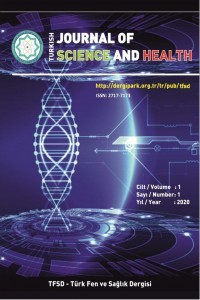Üst Çene Defektinin Obturatör ile Rehabilitasyonu
Obturator, Protetik rehabilitasyon, Üst çene defektleri
Rehabilitation of Maxillary Defect with Obturator: Case Report
Obturator, Prosthetic rehabilitation, Maxillary defects,
___
- Yazdanie N, Mandersen RD (1989). Prosthetic management and rehabilitation of an extensive intraoral and facial defect. Int J Prosthodont 2: 550-554.
- Adisman IK (1990). Prosthesis serviceability for acquired jaw defects. Dent Clin North Am 34: 265- 283.
- Korkmaz FM (2008) Maksiller defektlerde kuvvet dağılımının uygulanan implantların tip ve lokalizasyonlarına göre sonlu elemanlar analizi yöntemiyle değerlendirilmesi. Doktora Tezi. Ankara: Gazi Üniversitesi
- Yaluğ S,Nalbant L (1998). Bir bukkal uzantılı obtüratör yapımı. Cumhuriyet Ünv. Diş Hek Fak Dergisi 1: 78-80.
- Günay Y, Atay A, Karayazgan B, Oruç S. (2009) Yüz protezlerinin kullanım süresinde etkili olan klinik faktörler: iki olgu sunumu. Gülhane Tıp Derg 51: 182-185.
- Okay DJ, Genden E, Buchbinder D, Urken M. (2001) Prosthodontic guidelines for surgical reconstruction of the maxilla: a classification system of defects. Journal Prosthet Dent 200186(4): 352-363.
- Sipahi C. (2006) İmplant destekli çene-yüz protezlerinde retansiyon prensipleri. Gülhane Tıp Derg 48: 119-124.
- Keyf F (2001). Obturator prostheses for hemimaxillectomy patients. Journal of Oral Rehabilitation 28(9): 821-9.
- Buckner H (1974). Construction of a denture with hollow obturator, lid, and soft acrylic lining. J Prosthet Dent 31: 95-9.
- İslamoğlu İ (1984). Patolojik veya travmatik sebeplerle kazanılmış maksiller defektlerde protezist açısından preoperalif ve postoperatif uygulamalar. Oral Derg 1: 16-8.
- Hasanreisoğlu U, Gürbüz A (1984). Üst Çene rezeksiyonlarında uygulanan protezler. Ankara Üniv Diş Hek Fak Derg 11: 110-27.
- Şeker E, Kayış M. (2016) Parsiyel maksillektomi vakalarının implantüstü ber ve doğal diş destekli bukkal flanj obturatörler ile rehabilitasyonu: 2 Vaka raporu. A.Ü. Diş Hek. Fak. Derg. 43(3):179-185.
- Aramany MA (1978) Basic principles of obturator design for partially edentulous patients. Part I: Classification.J Prosthedent, 40(5):554-57.
- Yazıcıoğlu H (2001). Adheziv ve adheziv temizleme ajanının yumuşak akril ve silikonların bazı fiziksel özelliklerine etkisi. T Klin Diş Hek Bil Derg 7:35-40.
- Shimodaira K, Yoshida H, Mizukami M, Funakubo T (1994). Obturator prosthesis conforming to movement of the soft palate: a clinical report. J Prosthet Dent 71: 547-51.
- Özdemir AK, Coşkun A, Tunalı A, Yaluğ S (1998). Maksiler rezeksiyonların protetik obturasyonu. Cumhuriyet Üniv Diş Hek Fak Derg 1: 73-7.
- Chalian AV, Drane JB, Standish SM (1971). Maxillofacial Prosthetics. Multidisiplinary practice. The Williams& Wilkins Co, Baltimore, 133-148.
- Aladağ Lİ, Güngör H, Ahmetoğlu F, Holoğlu B, Aras MH (2009). Kısmi maksillektomi yapılmış hastaların hollow bulb obturatör ile protetik rehabilitasyonu: İki vaka raporu. Atatürk Üniv Diş Hek Fak Derg. 19(2):105- 110,
- Albrektsson T, Zarb G, Wortrhington P,et al (1986). The long-term efficacy of currently used dental implants: A review and proposed criteria of success. Int J Oral Maxillofac Implants 1:11
- Sing K, Sing S.V,Mishra N, Aagrawal K. K (2013). Manage- ment of maxillectomy defect with a hybrid hollow bulb obturator. BMJ. Case Reports. 10: 1.
- Başlangıç: 2020
- Yayıncı: Ümit Muhammet KOÇYİĞİT
Hemşirelik Öğrencilerinin Manevi Değerlerinin Bireyselleştirilmiş Bakım Algılarına Etkisi
Spiritüel Bakımın Hemşirelikteki Önemi
Aisha SADDİQA, Osman ÇAKMAK, Muhammad USMAN, Salih ÖKTEN
Üst Çene Defektinin Obturatör ile Rehabilitasyonu
Kubilay Barış ÇİÇEK, Tuğba HERGÜNER
Asemptomatik Tansiyon Yüksekliğine Acil Tıp Asistanlarının Yaklaşımının Değerlendirilmesi
Erhan ARIKAN, Nurcan ARIKAN, Ahmet AKTAŞ, İsa ARDAHANLI
Yaşlı Bakım Öğrencilerinin Yaşlılara Yönelik Tutumları Ve Etkileyen Faktörlerin Belirlenmesi
Şimşek ÇELİK, Ertuğ GÜNSOY, Behnan GÜLÜNAY, Pelin ÇELİK
Üniversite Öğrencilerinin Zayıflama Haplarına Yönelik Tutumları
Ayşegül BAYRAMOĞLU, Pelin DEMİR, Sibel BUZKURT
9-Bromofenantren’in Bromlanma Şartlarının Belirlenmesi Üzerine Çalışmalar ve Ön Sonuçlar
Osman ÇAKMAK, Nursel KARAOĞLAN, Kıymet BERKİL, Seda DUMAN
Pandemide Uzaktan Eğitim: Sağlık Hizmetleri Meslek Yüksekokulu Öğrencilerinin Görüşleri ve Önerileri
